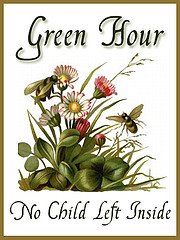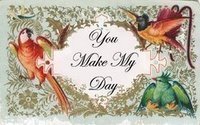Friday, October 30, 2009
Lush love ... and how to clean the loo
More interesting posts are planned … but while I work on those I thought I would share an excerpt from the wonderful Shannon Lush whose books 'Speed Cleaning' and 'Spotless' are my new favourites.
Her show has been on TV here lately, and while she's not the most charismatic television presenter, she's had me cleaning out the inside of our kettle (with CLR and a scourer), polishing the silver (washing soda and aluminium foil) soaking net curtains in napisan and generally using bicarb (baking soda), vinegar and clove oil with gay abandon!
Her books are so detailed, she even gives precise instructions to a task most of us don't give much thought to ...
'How to Clean the Toilet'
(with two sponges, white vinegar, baking soda and a bowl of hot water).
1. Flush the toilet to wet the sides of the bowl.
2. Sprinkle bicarb soda over the inside of the bowl.
3. Wipe the top of the cistern
4. Wipe the top of the lid, under the lid, the top of the seat and under the seat using bicarb and white vinegar and the two sponge technique.
5. Splash white vinegar over the bicarb in the bowl, then use a toilet brush to scrub, including up and around the rim.
6. Wipe the top of the rim with a sponge that’s been dipped in vinegar
7. Wash the sponge in hot water and wipe rim again.
9. Flush
9. Rinse the sponge in white vinegar and wipe the outside of the toilet bowl right to the floor including the plumbing at the back.
10. Congratulations, you’re done!
(the two sponge technique - one damp sponge dipped in baking soda, one sponge rung out with white vinegar, put the vinegar one on top of the baking soda one and wipe, using the pressure of your hand to squeeze the vinegar into the baking soda).
Personally, the toilet is one place I don't use baking soda and vinegar ... but I'm sure it would work. On that note, I am really delighted to see that Ecostore have changed the formulation for their previously useless toilet cleaner!
More interesting posts soon!
Yours with rubber gloves on,
Gypsy xx
Saturday, October 10, 2009
Area of Play 5 - Music
 photocredit:Chantelle
photocredit:ChantelleAlas I'm not much of a musician myself ... given a choice, I will listen to National Radio rather than a music station ... and faced with an array of musical instruments I just freeze. This makes doing music with kids a little bit intimidating.
"Get to know the (musical) equipment well yourself. Try out all the instruments and find what different sounds you can make. Be alert for spontaneous music play ...' Maureen Woodhams, Making Music With Children.
Playcentre, Montessori and Steiner/Waldorf all have very different approaches to musical education for preschoolers ... and given my own dunce status I hesitate to assume any authority here. So, as always, comments and debate always welcome!
 photocredit:anonymous
photocredit:anonymous"Become attentive to what the children are doing musically, both in focused music sessions and in their general play. This may involve stopping being active yourself so you can spend a few minutes just watching and listening. Children often chant or sing a pattern of words or a snatch of tune, especially during solitary play... musical interactions, like conversation, often occur while adults and children are doing something else together and are a joy when you start to notice and extend them." Maureen Woodhams
Playcentre
In a Playcentre, the 'music area' will usually be well resourced with a range of musical instruments - shakers, tambourines, drums, ukuleles, perhaps an old piano. There will usually be a CD player and a collection of recorded kids music ... which will often play loudly during the session.
Adults are encouraged to recognise when children show an interest in the music area, and play along side them, exploring the different instruments, dancing and singing.
"The provision of an attractive display of musical instruments and objects ensures that children have independent access to some music experiences whenever they choose. It also ensures that when a play interaction takes a musical turn, or an adult sees a way to extend a child's learning following a music interest, some materials which might support this are directly to hand. Maureen Woodhams
Steiner/Waldorf
As in all areas of play, Waldorf education is concerned with protecting and nurturing the senses, so in this instance it’s the sense of hearing. As children's hearing develops, they need first of all to hear real, living, human sounds - voices of course, and clapping rhythms are often considered very appropriate. The pentatonic scale is recommended for the early years -this has five pitches per octave and sounds lighter and more 'floaty' somehow.
You won't see many, if any, musical instruments in a Steiner/Waldorf kindergarten. Carrie was very kind to share some excerpts from 'In a Nutshell' with me that explain why.
"Because we prefer to offer the children open-ended play materials- that is, materials which can be used in many different ways, according to the child's needs of the moment - we also do not provide many of the traditional rhythm toys. However, some teachers do have bells, gourds or perhaps a drum or pentatonic xylophone available in the classroom.....It is important that these instruments produce a good quality sound, and in the case of the xylophone, that the notes are in tune. The children may play freely with these instruments, as long as they treat them with appropriate care and the sounds do not become disruptive to the mood of the classroom" Nancy Foster, In a Nutshell
You might say that if Steiner/Waldorf is concerned with protecting the senses, Montessori is concerned with perfecting them. I think no where is this more obvious than with music.
In the Montessori 3-6 programme, children are given materials to encourage them to listen carefully and learn to differentiate not only different sounds, but different pitches too. Games such as sorting objects by sound, recognising pitch using glasses of water, or the Montessori bells encourage this precision.
Making a joyful noise
 photocredit:Melissa
photocredit:MelissaOf course, what these three very different approaches have in common is seeking to encourage and develop a sense of musical appreciation in our children (so they can be groupies too!). I love the idea of teaching listening skills in Montessori, I love that the Steiner approach doesn't abuse a child's ears with tinny poppy kiddy music, and I love that Playcentre lets kids really have fun and enjoy music in all its wonderful guises. After all, banging pots and pans in the kitchen is as much a music lesson as anything else! Children love and deserve the opportunity to listen to live music where possible, and to experiment with making their own music too.
So, a few fun ideas for bringing music into your pre-schoolers home!
- sing all the time. Have special songs for special times of the day, and lots of songs just because. Don't worry that you can't sing in tune, honestly, your child won't mind!
- make lots of 'ad hoc' instruments. Bang pots, put small objects in glass jars (with supervision), fill glasses with water and tap them with spoons.
- play silence games ... encourage your children to listen to the quieter sounds around them.
- take your children to see live music - buskers, brass bands, folk bands playing at the markets ... start asking about where you might be able to find real instruments being played
Enjoy!

photocredit:Rodent
Thursday, October 1, 2009
Imitation is the sincerest form of flattery
Up till now I have just been too embarassed to post, as I just wasn't achieving anything other than feeding, clothing and occassionally cleaning up after the children. But, spring has given me new motivation ... and I am really keen to keep going with it!
So, in the spirit of public accountability here is my 'Monthly Review' for September:
Goals for September
- Organise wardrobe
Did this - and its wonderful! No longer do I have to wade through all my preggie clothes every time I need a clean pair of jeans, or a change of pyjamas at 3 in the morning when the baby has spilled up all over me. However, I now have a very large bag of clothes that need sorting through to dump/sell.
- Create a plan for TradeMe selling
Did this - and managed to sell about 5 'lots' so far. I have another 12 lots to go, plus all those old maternity/fat clothes ... but progress has been made. (this was on my to-do list back in May, so good to finally get some traction).
- Organise medicine cabinets
- Done ... I can't tell you the joy these give me when I open them! (yes, I'm really THAT sad!)
- Organise linen cupboard
- Done, and in the progress I found a whole pile of cloth wipes, saving me a big of money as I thought I was going to have to buy some more.
- Stick to grocery budget, implement 3 weekly shopping
- FAIL FAIL FAIL. Bad bad month for grocery shopping, and the worst thing is I didn't even realise till I did our monthly financial spreadsheet.
Goals for October
- write 2 more 'areas of play' posts. one on music, the other on either creativity or blockplay, depending on what books I can access.
- stick to grocery budget - strictly. Still working on how to do this - thinking about taking Sophie Gray's advice on a 'cash budget' - but detailed menu planning will be a part of this.
- bring Little Guys' baby book up to date.
- write list of Christmas gifts and stick to a maximum of $15 per person for gifts.
- organise spare room wardrobe. This is the last of my decluttering projects, but for some reason I am putting it off.
- get at least 8 more listings up on TradeMe
So, what's on your 'workplan' for the month ahead?





